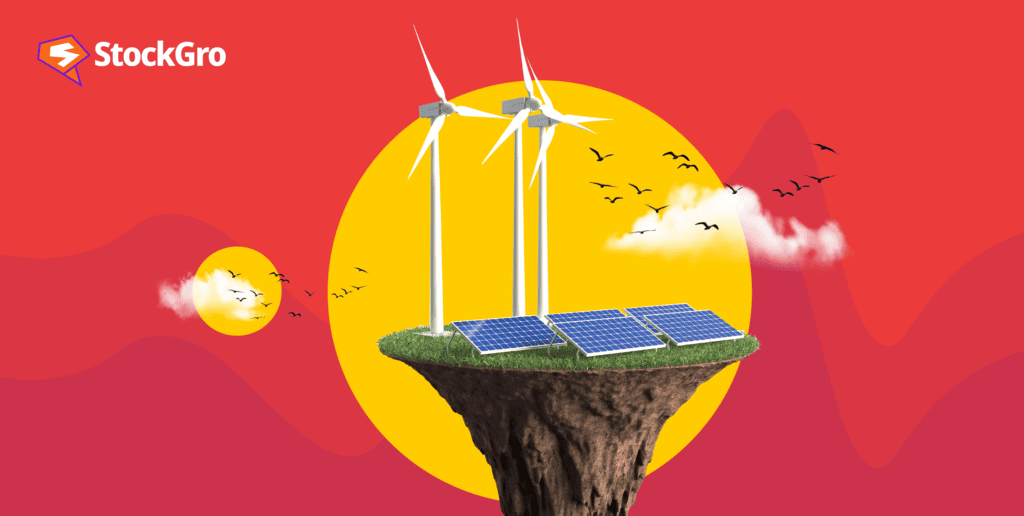
Sustainability concerns are becoming a priority in today’s world as technology continues to shape our way of life. Although many factors contribute to environmental issues, energy is still the primary driver of climate change.
India, home to 1.4 billion people, has a considerable energy demand to support its rapidly developing economy. However, India has been taking measures to fight the climate change issues by shifting towards renewable energy sources in recent years.
India’s installed capacity for renewable energy is expected to grow to 174 GW in 2023, making up almost 37% of the nation’s overall energy supply.
With an estimated capacity of 280 GW by 2025, the research shows that India has surpassed its goal of adding 175 GW of renewable energy capacity by 2022.
In today’s article, we will dive deeper into the renewable energy sector in India, have a look at its growth landscape and talk about the best renewable energy sector stocks in India at present. Let’s begin.
Renewable energy industry in India: What is it?
Energy that derives from natural sources, such as sunlight and wind, and that can be replenished is known as renewable energy. To put it simply, this type of energy will hardly ever run out.
In contrast, non-renewable resources such as coal, oil, and gas require millions of years to create. Fossil fuels release harmful greenhouse gases like carbon dioxide into the atmosphere when used as an energy source.
Also read: The role of the energy sector in powering India’s growth
Compared with burning fossil fuels, generating renewable energy produces a lot less emissions. Renewable energy must replace fossil fuels to solve the global warming crisis.
More and more energy is being produced globally from cleaner sources, even though fossil fuels still account for more than 80% of total energy production. India has seen a significant paradigm shift as a result of the movement towards renewable energy, along with a rise in global attempts to combat the impacts of climate change.
Currently, about 12.3% of India’s energy comes from renewable sources. The percentage share of renewable energy in India is 7.5% for solar, 2.5% for wind, 0.4% for small hydro, and 0.8% for biomass and bagasse.
| Power generation source | Percentage share in India |
| Thermal | 78% |
| Renewable | 12% |
| Hydro | 7% |
| Nuclear | 3% |
India has made significant progress towards achieving both its green energy objective and the UN’s SDG-7 (United Nations Sustainable Development Goal-7) in the past few years. We can see this in the country’s investments, technical adoptions, policy reforms, and many other measures.
In keeping with its commitment to take action against climate change, India plans to satisfy 50% of its power demand from renewable energy sources by 2030 and reach net zero emissions by 2070.
Evolution of the renewable energy industry in India
India has had rapid economic expansion in the past few years, which has kept up with the country’s commercial energy demand. India mainly relies on oil and coal to cover its energy demands.
However, for sustainable growth, India has always been dedicated to exploring more alternative energy sources. Hydropower was the first to enter the Indian energy perspective, with the establishment of significant hydroelectric power facilities.
Numerous governmental and regulatory actions have encouraged the growth of hydropower and made investments easier over time.
To ensure the nation’s long-term energy independence, the Bhabha Atomic Research Centre (BARC) was established in the 1950s. As of right now, India is the only developing country with nuclear reactors for generating power that were created, evaluated, and deployed domestically.
The National Aeronautical Laboratory (NAL) in India produced windmills in the 1960s, mainly for irrigation water supply. This marked the beginning of work on wind energy within the country.
India, having made significant progress in solar energy solutions, is also leading the International Solar Alliance (ISA), a collaborative platform to enhance the adoption of solar energy technology.
In 2018, India also established a goal to generate 50% of its power from non-fossil fuel sources by 2030. The Indian government also voiced its concerns about the environment at the Conference of the Parties (COP26) and showcased its Panchamrit, or five nectar components, climate action strategy there.
According to this strategy, the country wants to produce 500 GW of green energy by 2030, using hydropower, solar power, wind power, and biopower applications.
Current market growth in India
India has 165.94 GW of installed renewable energy capacity (which includes hydro) as of October 2022, accounting for 40.6% of the country’s total installed power capacity.
Compared to 2.6 GW for the initial three months of FY22, the non-hydro renewable energy capacity increase for the initial three months of FY23 was 4.2 GW.
With the addition of large hydro and nuclear power plants, India’s installed non-fossil fuel capacity has expanded by 396% in the previous 8.5 years to exceed 176.49 GW.
With a 9.83% annual increase in renewable energy additions in 2022, India had the most rapid growth. As of mid-2023, the installed solar energy capacity has grown by 30 times during the previous nine years to 70.10 GW.
The future of the renewable energy industry in India
India’s goal by the end of the decade is to have reduced the economy’s carbon intensity by less than 45%. India has consistently shown that the nation is determined to take the lead in tackling climate change.
Investments in renewable energy are expected to soar by 83% to USD 16.5 billion in 2024. R. K. Singh, Minister of New and Renewable Energy in India, stated in an interview with a news agency that India is expected to add 25 GW of renewable energy capacity by 2024, which would require an investment of Rs 1,37,500 crore (roughly USD 16.5 billion).
This would be more than the 13.5 GW seen in 2023, which would require an investment of Rs 74,250 crore (approximately USD 9 billion).
The nation’s goal is to reach net zero emissions by 2070, in addition to meeting the following short-term objectives:
- Reaching 500 GW of renewable energy capacity by 2030,
- Achieving 50% of energy needs from renewable sources,
- Lowering total emissions by one billion tonnes by the year 2030 and
- Achieving a 45% reduction in India’s GDP’s emissions intensity by 2030.
By 2040, it’s predicted that 49% of all power will come from renewable sources due to the adoption of more energy-efficient batteries for energy storage, which would further reduce the expense of solar energy by 66% compared to its present level.
India’s power industry is changing as a result of its high aspirations for renewable energy. The need for energy to power homes, companies, and communities is being driven by the growing population as well as the increasing electrification of rural houses.
Also read: The past, present, and future of the Indian agriculture industry
Top renewable energy companies in India
Renewable energy companies in India, like Tata Power, have high expectations and plan to invest heavily in the sector. The Adani group plans to invest US$20 billion in renewable energy, with a significant portion going towards the production of hydrogen.
Reliance also plans to allocate $10 billion over the next few years for similar initiatives. Investing in businesses that offer green energy is also an alternative strategy to profit from this megatrend.
If you are willing to make an investment in renewable energy in India, here is a list of the best renewable energy stocks in India by market cap on the BSE as of December 15, 2023.
| Company | Last price (₹) | Market cap (₹ cr) |
| NTPC Ltd | 297.90 | 288,863 |
| Adani Green Energy Ltd. | 1528.10 | 242,063 |
| The Tata Power Company Ltd. | 331.95 | 106,085 |
| NHPC Ltd. | 64.45 | 64,690 |
| Suzlon Energy Ltd. | 38.10 | 51,794 |
Also read: Fueling India’s growth engine: Evolution and outlook of oil & gas industryttps
Conclusion
To sum up, the renewable energy sector in India has grown rapidly in recent years, thanks to a number of factors like numerous government initiatives, foreign investment, and technical innovation.
Investors who are looking to get in on India’s renewable energy sector boom might find this an ideal time.

